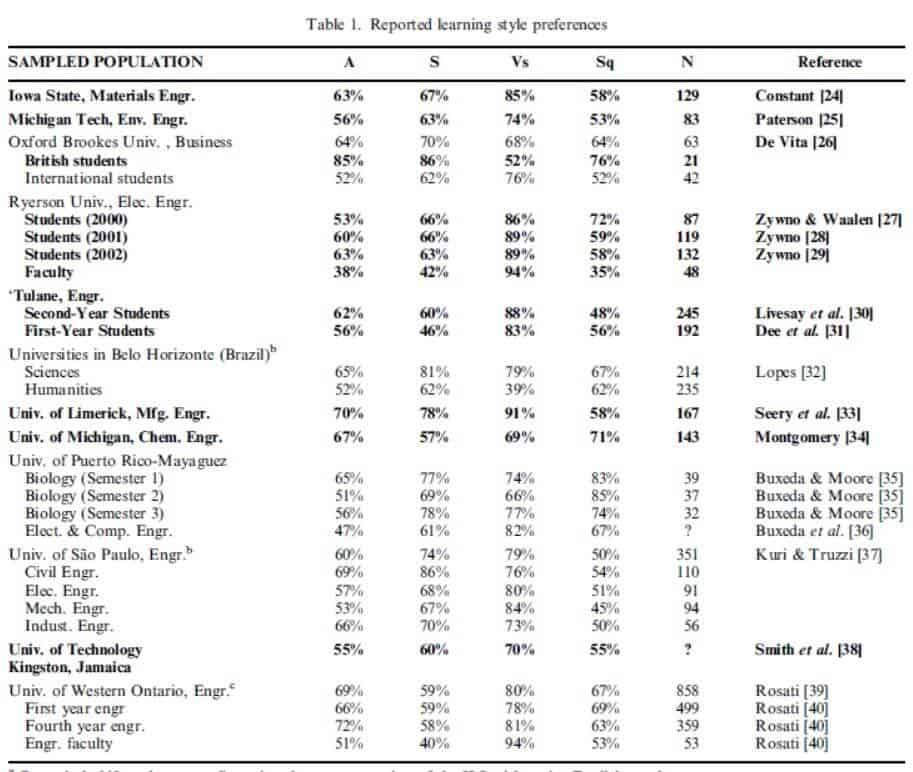The Most Common Learning Styles & Why They're Important

Why are learning styles important?
The purpose of this article is to introduce and familiarize the reader with the major styles of learning and provide them with resources for additional education. Homeschool parents can have significantly more impact on their child's learning if they are able to successfully identify their learning style and then cater education to their needs.
- The preferred learning mode of a student will have strong influences on their behavior during different learning environments.
- When a student accesses information through their learning mode there is a strong correlation to an increase in comprehension and motivation.
- A student will learn best when his or her learning mode is matched with an appropriate learning method/strategy.
The 'types of learning styles' were first popularized during the 80s after they were published by Dr. Neil Flemming. Flemming identified 3-4 styles of learning. At present, some researchers have identified many more variations and specifications. The largest academically justified number is 70 different styles.
There is an enormous amount of material available for research and continued education in this area. Google Scholar can provide additional sources that go far outside of the scope of this article.
Dimensions of Learning Style
One of the first major research into learning styles and learning types was published in a paper called Learning and Teaching Styles In Engineering Education.

The full paper by Professor Felder can be read here. Felder broke learning styles down into multiple categories. The main categories are BSensing and Intuitive Learners, Visual and Auditory Learners, Inductive and Deductive Learners, Active and Reflective Learners, and Sequential and Global Learners. The purpose of his paper was to show that the learning styles of engineering students was usually at odds with the teaching styles of their professors. His thesis is that students have a very diverse and wide range of learning styles and that professors accommodate for only a few of these.
"A class in which students are always passive is a class in which neither the active experimenter nor the reflective observer can learn effectively. Unfortunately, most engineering classes fall into this category."
The three main learning styles (VAK and VARK)
There are three popular learning styles: visual, auditory, and kinesthetic learners. However, these three styles are overly broad and generalized. These are a good starting point, but learning can be categorized much further. While these categories are often fairly self-explanatory, this article will provide a more in-depth explanation.
Visual Learners
This is usually thought to be the largest category of learners, comprising around 60%+ of the population. Visual learners thrive when they can view concepts. They usually enjoy reading, drawing, seeing, and written instruction. They are enticed by flash cards and enjoy highlighting their notes and books. Charts, maps, diagrams -- all these things are not only appealing, they are usually highly beneficial. They learn best when they can observe.
Auditory Learners
Auditory learners are less common than visual learners -- estimated to compromise around 30% of the population. These individuals learn best when they can hear the information. Written information may have diminished effects upon them. They benefit from talking about materials, discussing, or engaging in arguments. Verbal repetitions of key concepts works better than flash cards for auditory learners. In a traditional class, they would benefit the most from discussions, debates, tapes, and lectures. Videos, music, and lectures are all excellent ways to implement curriculum.
Kinesthetic Learners

This is the least common type of learner -- only around 5% of the population is a true kinesthetic learner. These individuals need to move, touch, feel, hold, and get active. Field trips are one of their favorite ways to learn. So are hands-on experiments and any activity requiring construction. These learners might trouble teachers because of their constant need to be moving. If a kinesthetic learner needs to memorize material it is best to allow the student to move, fidget, whistle, and engage in other similar behavior. They are often seen as problems in classrooms because the classroom environment is particularly incongruent with their learning style.
Reading/Writing
This style is not one of the three hallmarks of the VAK, but it is widely considered to be a fourth most basic type (VARK). This individual learns best when allowed to read and write the materials. The best form of memorization for this type of learner may be re-writing a sentence over and over.
Videos on the four major learning types (VARK)
The following videos are great resources and provide further information about these types.
Kinesthetic
Auditory
Visual
Reading/Writing
Additional learning types
A simple Google search will turn up any arbitrary number of types between 3 and 70. List articles may pick a fun number like 9 or 17. The VARK is sufficient to get any parent started and on the right track. It is uncertain that extreme specifications are actually particularly useful. What is most important is that the homeschool parent is aware that every child has a different and unique style of learning. Homeschooling parents have the ability to structure their 'classroom' to best fit the needs of their children. Being aware of the multiple types of learning can allow a parent to begin to optimize their child's education.
Another simple categorizations is listed below. This is the Felder-Silverman model which breaks up learning into a dichotomy with several categories. These categories are really 'dimensions'
Sensing or Intuitive
Sensing: Students are described as concrete thinkers, practical, and oriented towards facts and procedures.
Intuitive: Students are intuitive learners if they are abstract thinkers, innovative, and oriented towards theories and underlying meanings.
Visual or Verbal
Visual: Students are verbal learners when they prefer visual representations of the materials. Examples include diagrams, maps, pictures, charts, and other visual aids.
Verbal: A verbal learner will choose spoken and written explanations over the pictures and diagrams that the visual learner needs.
Active or Reflective
Active: These people are active learners because they learn by doing. They like trying things out and working in groups.
Reflective: A student is categorized as reflective when thinking things through and working alone are preferable.
Sequential or Global
Sequential: A student is categorized as sequential when they have a linear thinking process. They learn in small incremental steps towards a goal.
Global: A student is categorized as a global learner when they have a holistic thinking process and learn in large leaps.

Critics of learning style models
Lynn Curry wrote a critique of learning styles, beginning with the quote:
Like the blind men in the fable about the elephant, learning styles researchers tend to investigate only a part of the whole and thus have yet to provide a definitive picture of the matter before them.
Her three main arguments are as follows. 1) The definitions cause confusion. 2) There is not enough reliability and validity in the measurements. 3) There is difficulty in actually identifying the relevant characteristics in learners and in the educational setting.
The tendency among the learning styles researchers has been to rush prematurely into print and marketing with very early and preliminary indications of factor loadings based on one dataset.
Her thorough analysis is worth reading and interested readers can find the full critique here.
Another excellent investigation into the benefit and usefulness of learning styles can be found in Frank Coffield's paper "Should we be using learning styles?" His report examines 13 different styles. His conclusion states that the most important decision is "which model is chosen." The full report is 84 pages.
The most recent critique can be found on NPR.org. The source of the study can be found here.
When he reviewed studies of learning styles, he found no scientific evidence backing up the idea. "We have not found evidence from a randomized control trial supporting any of these," he says, "and until such evidence exists, we don't recommend that they be used."
Homeschool Base's response to learning style criticism
An entire sub-field of psychology has sprouted out of the 'learning styles' research. Even if studies like this one claim that there is no supporting evidence, we believe that identifying a child's learning style is still beneficial. Just because specifically catering to a child's preferred learning style might not bring about statistically significant results does not mean it isn't beneficial. Most homeschool parents will agree that forcing their children into certain learning styles can be like pulling teeth.
Understanding learning styles is beneficial because it does give insight into the cause for a child's actions. It helps to explain why children do the things they do and it allows homeschool parents to better prepare, predict, and mitigate. Furthermore, understanding a learning style does make it easier for the student to learn practical study methods that wil work best for him/her.
Most advocates for using learning styles in the home (or in the classroom) dismiss the possibility that there might be no conclusive scientific proof. They argue that they have seen learning styles in action, in the classroom, and in the home. They will say that children do normally have an predominant style of learning that they maintain and benefit from.
Recent developments and changes in the learning style model
These changes were made by Professor Felder in the most updated version of his paper. The most recent updates to the learning model was the elimination of the inductive / deductive dimension. Induction and deduction are the two types of logical reasoning and arguments. Induction and deduction are preferences and approaches to learning and problem solving. There was also a change in the visual/auditory dimension. Visual/auditory was changed to visual/verbal.
Induction and Deduction
The best style of teaching for non-graduate level students is induction. There are many names for induction including: problem-based learning, inquiry learning, trial and error, discovery learning, and so on. The popular learning style at universities is deductive learning. Deduction begins with premises, leads to a conclusion based in facts, and the proceeds to application.
The lecture paradigm is rooted in deductive education. While some students may prefer deductive education more than inductive, this is often preference and not learning style. Therefore, some teachers could use the 'fact' that some children are deductive learning to back their insistence on continuing traditional classroom education.
Changes to the Visual/Auditory Dimension
This is the second modern change that was made to the original theory. Essentially visual/auditory was changed to visual/verbal in order to solve the dilemma of written word. See, on the one hand written word is understood and perceived visually. Obviously, this cannot be considered 'auditory.' On the other hand, it would be incorrect to assume written prose is 'visual' because certainly it should not be categorized alongside paintings and pictures. Pairing visual and verbal solves the problem because verbal and written word can then be categorized together.
Sources and References:
Learn how to identify your child's learning style.
How to teach based on your child's learning style.
Learning and Teaching Styles In Engineering Education by Richard M. Felder.
A Critique of the Research on Learning Styles by Lynn Curry.
Should we be using learning styles by Frank Coffield's
Think You're An Auditory Or Visual Learner? Scientists Say It's Unlikely via NPR.org
Learning Styles Debunked - psychologicalscience.org







Leave a Reply